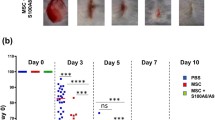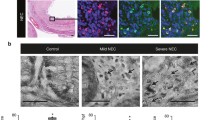Abstract
Introduction
Snail, a transcription factor linked to epithelial to mesenchymal transition (EMT) during embryonic development and tumor progression, is associated with migration of cells. During inflammation and tissue injury, cell movement is also observed to provide the first line of defense against bacteria and to promote wound healing. Therefore, we studied the function of Snail in activated macrophages in a variety of inflammatory processes.
Materials and Methods
In this study, we examined the expression and localization of Snail during inflammation and tissue injury in rats and human tissue specimens, by immunohistochemistry, Western blot, and real-time PCR. We investigated Snail expression after stimulation of macrophages with TGF-β1, LPS, Interleukin-8, and MMP-3 in vitro. To further understand the role of Snail in activated macrophages, we used Stealth siRNA against Snail, transfected the human macrophage cell line THP-1, and measured migration of cells in an in vitro invasion assay.
Results and Discussion
We found a strong, transient, and time-dependent activation of Snail in migrating macrophages at the sites of injury in vivo and in vitro, as well as in patients with inflammatory bowel disease. Furthermore, we showed that induction of Snail in macrophages is dependent on TGF-β1 signaling pathway. Downregulation of Snail by Stealth siRNA led to impaired migration of THP-1 cells in an invasion assay after stimulation with TGF-β1.
Conclusion
We conclude that TGF-β1 induced migration of activated macrophages during inflammation and wound healing is mediated by snail. These results give insights in a novel EMT-like mechanism present in immune cell movement during tissue injury.







Similar content being viewed by others
References
Thiery JP, Sleeman JP. Complex networks orchestrate epithelial-mesenchymal transitions. Nat Rev Mol Cell Biol 2006;7(2):131–142.
Acloque H, Thiery JP, Nieto MA. The physiology and pathology of the EMT. Meeting on the epithelial-mesenchymal transition. EMBO Rep 2008;9(4):322–326.
Thiery JP. Epithelial-mesenchymal transitions in development and pathologies. Curr Opin Cell Biol 2003;15(6):740–746.
Nieto MA. The snail superfamily of zinc-finger transcription factors. Nat Rev Mol Cell Biol 2002;3(3):155–166.
Barrallo-Gimeno A, Nieto MA. The Snail genes as inducers of cell movement and survival: implications in development and cancer. Development 2005;132(14):3151–3161.
Witte MB, Barbul A. General principles of wound healing. Surg Clin North Am 1997;77(3):509–528.
MacDonald TT, Di Sabatino A, Gordon JN. Immunopathogenesis of Crohn’s disease. JPEN J Parenter Enteral Nutr 2005;29(4 Suppl):S118–S124. discussion S124–S125, S184–S188.
Macdonald TT, Monteleone G. Immunity, inflammation, and allergy in the gut. Science 2005;307(5717):1920–1925.
Roberts AB. Transforming growth factor-beta: activity and efficacy in animal models of wound healing. Wound Repair Regen 1995;3(4):408–418.
Wahl SM et al. Transforming growth factor type beta induces monocyte chemotaxis and growth factor production. Proc Natl Acad Sci USA 1987;84(16):5788–5792.
Del Zotto B et al. TGF-beta1 production in inflammatory bowel disease: differing production patterns in Crohn’s disease and ulcerative colitis. Clin Exp Immunol 2003;134(1):120–126.
Ohtsuka Y, Sanderson IR. Transforming growth factor-beta: an important cytokine in the mucosal immune response. Curr Opin Gastroenterol 2000;16(6):541–545.
Smythies LE et al. Mucosal IL-8 and TGF-beta recruit blood monocytes: evidence for cross-talk between the lamina propria stroma and myeloid cells. J Leukoc Biol 2006;80(3):492–499.
Nerusu KC et al. Matrix metalloproteinase-3 (stromelysin-1) in acute inflammatory tissue injury. Exp Mol Pathol 2007;83(2):169–176.
Shima I et al. Expression of matrix metalloproteinases in wound healing after glaucoma filtration surgery in rabbits. Ophthalmic Res 2007;39(6):315–324.
Hotz B et al. Epithelial to mesenchymal transition: expression of the regulators snail, slug, and twist in pancreatic cancer. Clin Cancer Res 2007;13(16):4769–4776.
Luster AD, Alon R, von Andrian UH. Immune cell migration in inflammation: present and future therapeutic targets. Nat Immunol 2005;6(12):1182–1190.
Granger DN, Kubes P. The microcirculation and inflammation: modulation of leukocyte-endothelial cell adhesion. J Leukoc Biol 1994;55(5):662–675.
Diacovo TG et al. Neutrophil rolling, arrest, and transmigration across activated, surface-adherent platelets via sequential action of P-selectin and the beta 2-integrin CD11b/CD18. Blood 1996;88(1):146–157.
Albelda SM, Smith CW, Ward PA. Adhesion molecules and inflammatory injury. Faseb J 1994;8(8):504–512.
Goerdt S et al. Alternative versus classical activation of macrophages. Pathobiology 1999;67(5–6):222–226.
Gordon S, Taylor PR. Monocyte and macrophage heterogeneity. Nat Rev Immunol 2005;5(12):953–964.
Godaly G et al. Neutrophil recruitment, chemokine receptors, and resistance to mucosal infection. J Leukoc Biol 2001;69(6):899–906.
Smythies LE et al. Human intestinal macrophages display profound inflammatory anergy despite avid phagocytic and bacteriocidal activity. J Clin Invest 2005;115(1):66–75.
Teng Y, Zeisberg M, Kalluri R. Transcriptional regulation of epithelial-mesenchymal transition. J Clin Invest 2007;117(2):304–306.
Arias AM. Epithelial mesenchymal interactions in cancer and development. Cell 2001;105(4):425–431.
Gavert N, Ben-Ze’ev A. Epithelial-mesenchymal transition and the invasive potential of tumors. Trends Mol Med 2008;14(5):199–209.
Metzstein MM, Horvitz HR. The C. elegans cell death specification gene ces-1 encodes a snail family zinc finger protein. Mol Cell 1999;4(3):309–319.
Mahida YR et al. Migration of human intestinal lamina propria lymphocytes, macrophages and eosinophils following the loss of surface epithelial cells. Clin Exp Immunol 1997;109(2):377–386.
Duffield JS. The inflammatory macrophage: a story of Jekyll and Hyde. Clin Sci (Lond) 2003;104(1):27–38.
Eaden JA, Abrams KR, Mayberry JF. The risk of colorectal cancer in ulcerative colitis: a meta-analysis. Gut 2001;48(4):526–535.
Xavier RJ, Podolsky DK. Unravelling the pathogenesis of inflammatory bowel disease. Nature 2007;448(7152):427–434.
Bouma G, Strober W. The immunological and genetic basis of inflammatory bowel disease. Nat Rev Immunol 2003;3(7):521–533.
Neurath MF et al. Regulation of T-cell apoptosis in inflammatory bowel disease: to die or not to die, that is the mucosal question. Trends Immunol 2001;22(1):21–26.
Radisky DC et al. Rac1b and reactive oxygen species mediate MMP-3-induced EMT and genomic instability. Nature 2005;436(7047):123–127.
Acknowledgments
We thank Marco Arndt, Steffi Valdeig, and René Heydrich for their technical support, and Professor C. Loddenkemper, MD, Charité, Department of Pathology for his expertise in interpretation of the histological data.
Author information
Authors and Affiliations
Corresponding author
Additional information
Birgit Hotz and Alexander Visekruna contributed equally to this work.
Rights and permissions
About this article
Cite this article
Hotz, B., Visekruna, A., Buhr, HJ. et al. Beyond Epithelial to Mesenchymal Transition: A Novel Role for the Transcription Factor Snail in Inflammation and Wound Healing. J Gastrointest Surg 14, 388–397 (2010). https://doi.org/10.1007/s11605-009-1068-3
Received:
Accepted:
Published:
Issue Date:
DOI: https://doi.org/10.1007/s11605-009-1068-3




